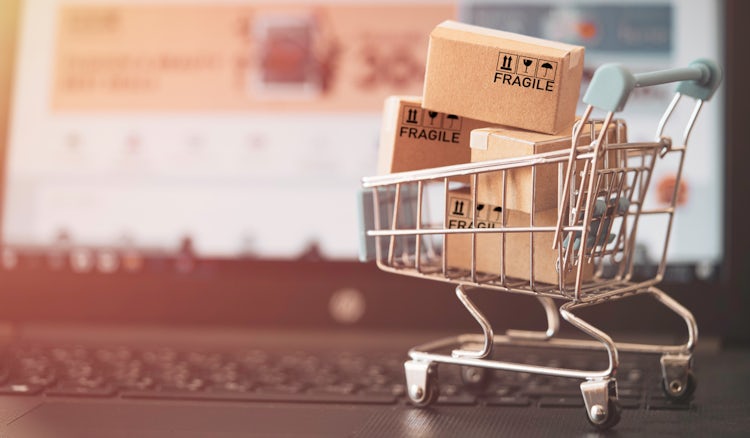How to create the right conditions for ecommerce in B2B
Ecommerce is growing rapidly in B2B as well as B2C brands but is still not the norm, so what’s the right model for customers as well as colleagues in sales and across the business?

For anyone working in B2B sales and marketing for the last 18 months, it’s a statement of the obvious that buyer behaviour has significantly changed as a result of the pandemic.
Here are just a few eye-catching stats:
- Two thirds of buyers prefer remote human interactions or digital self-service when buying or interacting with B2B organisations (McKinsey)
- Forty three percent of B2B buyers would prefer not to interact with a sales rep at all (Gartner)
- Eight out of 10 B2B leaders report that new, remote sales models are at least as effective, if not more, than traditional models (Gartner)
This has resulted in a huge boom in B2B ecommerce. It’s valued at $7.72tn worldwide, and forecast to grow to $25tn by 2028. Remarkably, global B2B ecommerce revenues are six times those of B2C ecommerce revenues.
And yet, for B2B brands, selling online is far from the norm. Ultimately, there is some way to go before B2B digital experiences are consistently as good as the best B2C ones.
So what are the secrets to succeeding in B2B ecommerce? We’ve been working with B2B brands over the past 20 years, helping them shift to an online selling model.
LISTEN: Inside B2B: How B2B brands can succeed in ecommerce
This article will share some of the big learnings we’ve found that can help to create the right conditions for B2B ecommerce success.
Choose the correct model of B2B ecommerce
The first thing B2B brands have to do is decide on the right model of ecommerce for them. There are essentially three models:
Supplier-oriented
These are online stores that operate similarly to B2C models. They have rows of products, buy buttons and shopping carts, etc. These are suitable for smaller items with high-scale demand, such as laptops, machine parts or home office supplies.
Intermediary-oriented
This is the largest segment of ecommerce (about 50% of the market) and is dominated by large marketplaces like Amazon Business and Alibaba. These are suitable for smaller B2B firms that don’t want to invest in their own platforms and are happy to sacrifice control in return.
Buyer-oriented (e-procurement)
These are for large organisations with big purchasing power. These platforms act as a marketplace with one customer and many suppliers, where RFPs are submitted and the buyer can choose the best fit.
When choosing the right model for your business, it’s always vital to put the customer at the heart of the decision. Ecommerce isn’t just a case of making your old sales process digital, rather it’s rethinking it from the buyer’s perspective.
Customer insight methods like personas and journey mapping should be carried out, as well as internal business analysis, to ensure the right model of ecommerce is chosen.
Create a distinctive digital experience
Choosing the right model of ecommerce is just the start. Your digital experience needs to reflect your customer’s needs, your brand and the best way to buy your products and services.
A Gartner survey of more than 1,100 B2B customers showed that customers struggle to distinguish supplier offerings from one another through digital alone: 64% of B2B buyers cannot differentiate between one B2B brand’s digital experience and another’s.
For example, consider the difference between two of Omobono’s clients – a cloud telecoms provider aimed at SMEs, and a hard-to-find drugs business aimed at pharmacists. For the telecoms client, the experience had to be fun, informative and use clever targeting techniques to upsell and cross-sell. By contrast, the drugs business was clear, technical, with no hint of upselling due to tight industry regulations.
Integrate sales reps into ecommerce
It’s tempting to think of ecommerce as a ‘replacement’ for sales reps, but the successful brands are integrating human sales ‘inside’ the experience. This is because digital is not the end goal, serving customers better is, and there will always be times where the human touch is valued.
Consider chatbots, virtual tours or buying guides, where live streaming or video could assist a considering customer. Or perhaps think of how digital diagnostic tools could help a customer identify their needs, while arming your sales teams with vital information about a prospect’s pain points.
Take small steps toward data and technical readiness
One of the trickiest hurdles to overcome when shifting to online selling is the use of data and integration with existing technical infrastructure. Most B2B organisations have data in pockets across the organisation, perhaps unstructured and hard to use by any CRM or personalisation engine.
Equally, you may be working with legacy supply chain management systems which are tricky to integrate with new ecommerce technologies.
Our advice is to take it slowly and in small steps.
Think carefully about what you really need the platform to do, and avoid being tempted into investing in all the bells and whistles from day one. Many brands buy a ‘Formula One’ enterprise solution, only to find out that no one in the business can drive it.
Likewise, with data, think about how you can get the data you really need into a usable format and augment it over time. Don’t try and personalise every aspect of your experience, run small tests and get good data on what works before acting.
Don’t forget mindsets and culture
Technology is only ever as good as the people that use it. Succeeding with ecommerce requires a new cultural mindset – testing, iterating and treating all mistakes as learning. And creating a growth mindset, where teams feel psychologically safe, is vital.
As well as mindsets, you’ll need to think of training and skills development for sales and marketing. Your team might need data skills, conversion rate optimisation, technical SEO, merchandising and content strategy.
Investing in new skills for your team can be a great way to build new muscles for the business, while showing commitment to employee growth.
Now is the time
We see a huge opportunity to invest in B2B ecommerce in 2021. Research firms predict this segment will more than treble in size in the next seven years.
We recommend a dedication to put customers first, integration with existing sales processes and technology, and a culture which supports small moves, learning and experimentation.
Now is the time to build the foundations for ecommerce success.
Simon McEvoy is head of strategy and Rebecca Pike is a strategist at Omobono.
This article was originally published in 2021, sponsored by Omobono, which has since been acquired by The Marketing Practice.






